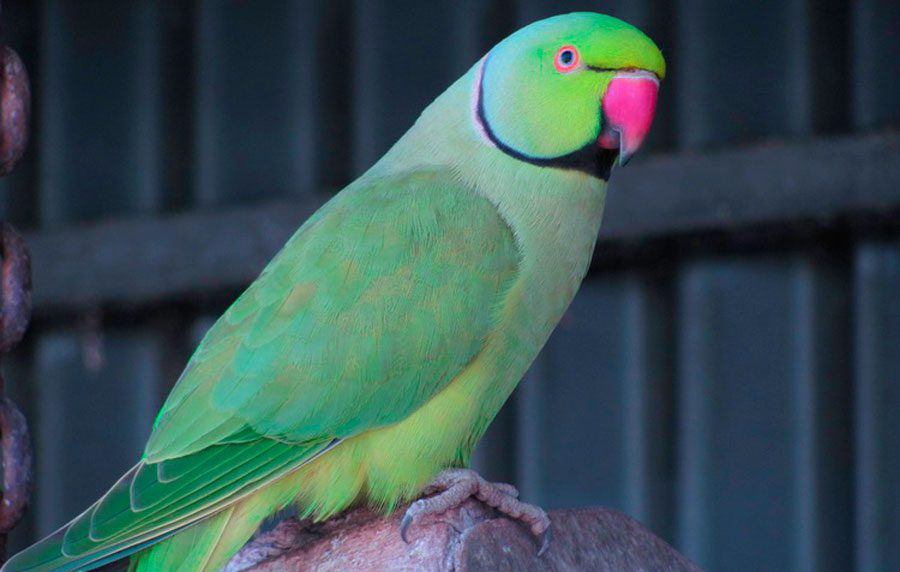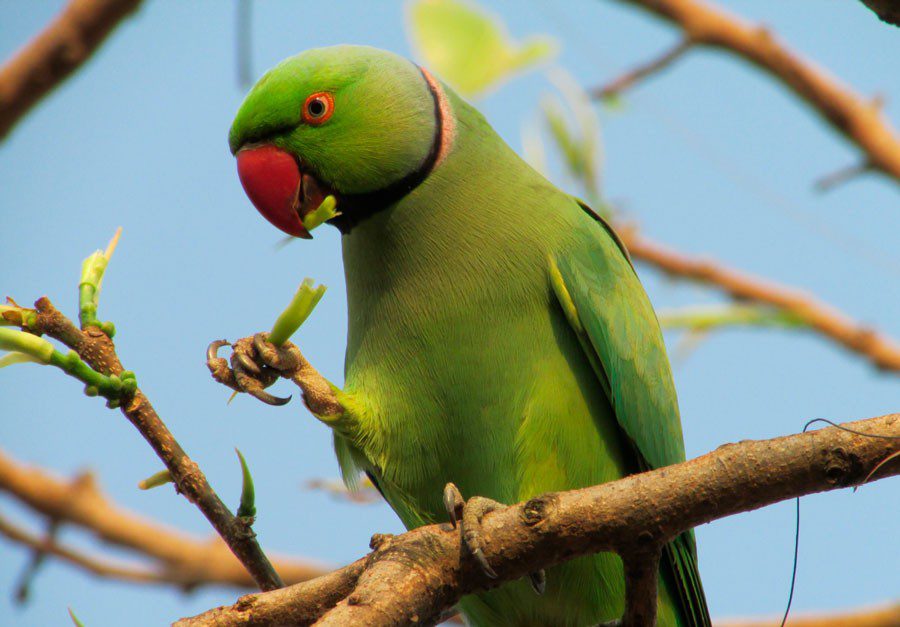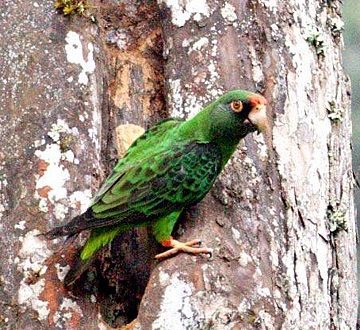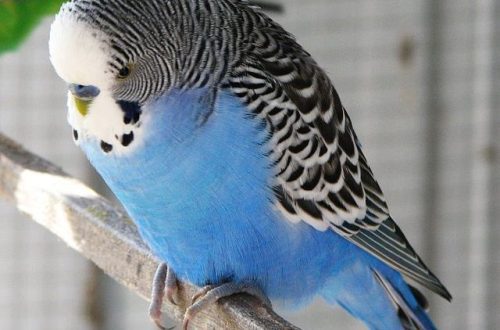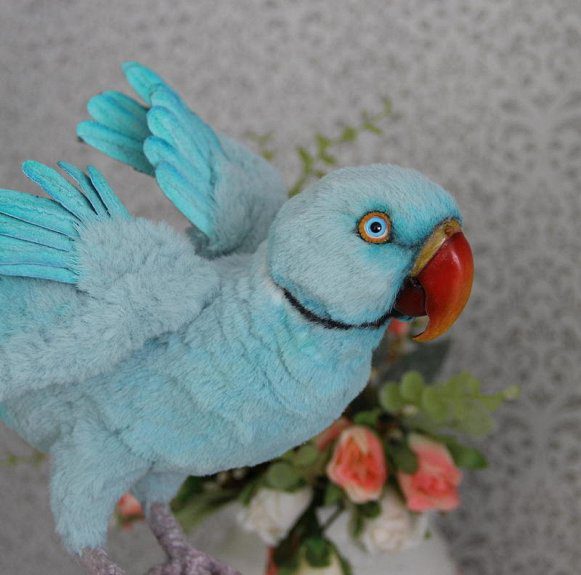
Cramer’s necklace parrot
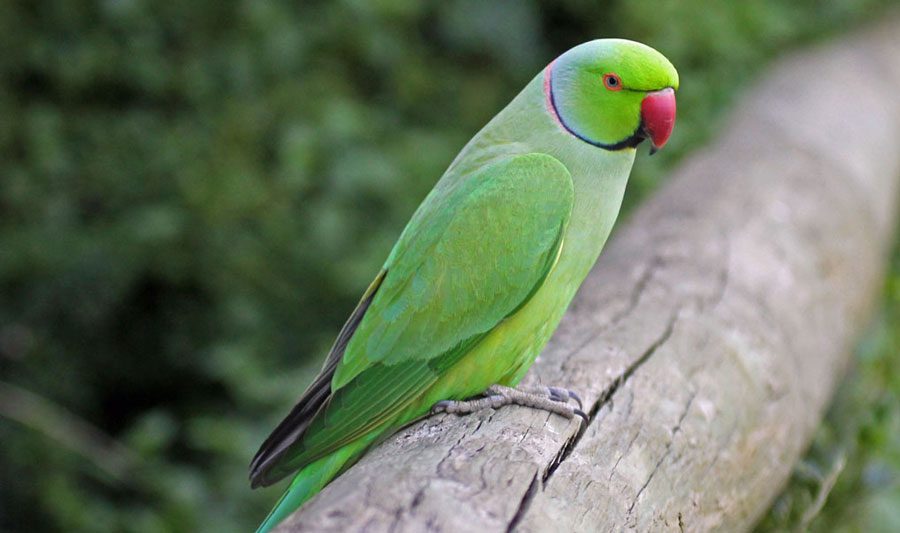
| Cramer’s necklace parakeet or Indian ringed parakeet | Psittacula krameri |
| Order | Parrots |
| family | Parrots |
| Race | ringed parrots |
Contents
Appearance of Kramer’s necklace parrot
The bird belongs to medium parrots, the tail is long, up to 20 cm. The size of the necklace parrot is about 40 cm, body weight is up to 140 g. The color of the body is predominantly grassy green, a black, barely noticeable stripe stretches from the eye to the beak, and the plumage is also black under the beak in the throat area. This species is characterized by sexual dimorphism; males and females differ from each other in color. The beak is powerful, red, paws are gray-pink. Breeders have bred many colors – blue, yellow, white, gray, various versions of green, variegated colors.
How to determine the sex of a necklace parrot?
Usually, by the time of puberty, males “acquire” a new element in color – a black, bordered with pink, necklace. It is fully formed by 3 years. In females, the plumage is usually duller in color, the tail is shorter, and the shape of the head is not as square.
Unfortunately, before the onset of this very puberty, it can be very problematic to determine the sex of these parrots; a DNA test can help, which will give an almost 100% guarantee. If this is not possible, then you can try to determine the sex based on the behavior of the bird – males, when they see their reflection in the mirror, can fold their wings with a “heart” and narrow their pupils at the same time. Usually the paws of males are not as powerful as those of females. The head of males is more square. The color in the area is more saturated. However, this method is not suitable for determining sex by external signs for albino and yellow mutations.
Females usually have a more knocked-down body shape, thick paws, when looking at their reflection, can throw their heads back and narrow the pupils.
Habitat and life in nature
The habitat is very wide, Indian ringed parrots live in Africa and Asia. Prefers to settle in forests, open landscapes and savannahs. I feel good next to a person, in agricultural landscapes and cities. Several colonies of departed pets were also formed in the USA, England, Belgium, Spain and Italy. The species adapts very well to any conditions where there is a food base.
Birds live in flocks, they do not meet alone. They can flock with other bird species. These are quite noisy parrots. They feed mainly on the ground and trees. The diet includes seeds of wild cereals, weeds, tree seeds, fruits, nuts, flowers and nectar. They attack crops of sunflower, corn, visit orchards. The diet may vary depending on the season, as well as the availability of certain feeds.
Reproduction
In nature, birds reach puberty by two years, but they start breeding at 3-4 years. The nesting period falls on January – April, sometimes July, depending on the habitat. Necklace parrots have a mating dance. They nest at a height, usually in hollows of trees, in rock crevices; they can use various holes in the walls of human buildings for nesting. The clutch usually contains 4 to 6 eggs; only the female incubates them for up to 34 days. The male feeds and protects her. At the age of 7 weeks, the chicks leave the nest. For some time they keep their parents who feed them.
Keeping Cramer’s Necklace Parrot
Why is a necklace parrot a good choice? Birds are unpretentious, quite quickly make contact with a person, smart and quick-witted. The necklace parrot “speaks”, their ability to imitate speech is quite impressive – 50 – 60 words. In addition, they can learn various sounds, simple tricks.
Necklace parrots live with proper care up to 30 years. However, among the cons are their rather loud and shrill screams, their destructive beak, which can ruin your property. They should not be kept with other types of parrots, especially smaller species, since necklace parrots are quite aggressive towards them and bitten fingers are only a small part of what they can do.
When keeping them separately from other species, there can be no talk of any joint walks, only separately, under your supervision. Cages with other birds are best removed for this time or covered.
The content of the Cramer’s necklace parrot is quite simple, it does not require any special conditions.
Before purchasing a parrot, take care of a suitable cage or aviary in advance. If in the future you plan to breed necklace parrots, then the best solution would be a spacious aviary with a length of at least 2 m. The net or rods in the cage must be strong, as these parrots use their beak well and are quite capable of destroying short-lived structures.
The cage should be in a well-lit room, without drafts, not in direct sunlight, not near heaters.
The comfortable temperature for keeping necklace parrots ranges from 15 to 25 degrees.
Perches of the appropriate diameter should be installed in the cage so that the bird completely wraps its paw around them. Do not forget about toys, koposilki – this species has a rather high level of intelligence, they need to be entertained, otherwise it is fraught with the fact that the bird will begin to entertain itself, destroying your house. Or even worse, out of boredom, he will begin to stress and pluck his feathers. In addition, there should be feeders, a drinking bowl, and, if possible, a bathing place in the cage.
Caring for the Cramer’s necklace parrot is simple. It is necessary to observe hygiene in the cage, properly feed the bird, provide access to clean drinking water, devote enough time to training the bird, monitor the state of health.
Feeding Cramer’s Necklace Parrot
The basis of the diet of necklace parrots is a grain mixture. It is quite suitable for industrial production for medium parrots. The feed must be packed in airtight packaging, free of foreign impurities and odors, free of dyes and artificial additives. The basis of the feed should be canary seed, millet, a small amount of oats, buckwheat, safflower and sunflower. Offer birds Senegalese millet, succulent feed (greens, branch food), sprouted cereals, fruits and vegetables allowed for birds. The cell must contain sources of calcium and minerals – sepia, chalk, mineral mixture.
Breeding at home
Breeding necklace parrots is a rather responsible business. Unfortunately, it is better not to breed these birds in a cage, since the percentage of probability of breeding offspring in such conditions is rather low, in addition, due to the small space in the cage, the female can be aggressive not only to the chicks, but also to the male, which may end in death.
A spacious aviary is suitable for breeding. Birds must be a formed heterosexual pair.
Birds need to nest from the age of at least 3 years. Birds must be healthy and well-fed.
Before hanging the nesting house, it is necessary to prepare the organisms of birds for this energy-consuming process. For this, daylight hours are gradually increased to at least 15 hours a month, protein feed of animal origin, more sprouted grains, fruits and vegetables are introduced into the diet.
The nesting house must be with a minimum size of 25x25x50 cm. It must be made of durable materials, otherwise, the birds will simply gnaw it with their powerful beaks. It is necessary to pour wood shavings or sawdust into the house, preferably hardwood trees. Usually after a short time the birds are interested in him.
Make sure that the female does not behave aggressively towards the male. After the first egg is laid, animal protein is removed from the diet and reintroduced when the chicks are born.
Sometimes the female throws the clutch, but do not despair, you can try another time. Chicks are born blind and covered only with down. By 2 months they fledge and leave the nesting house. Their plumage is faded, the beak is pale. By 2,5 months, they begin to feed on their own.
It is better to take chicks for supplementary feeding at the age of not earlier than 3 weeks. So they quickly get used to the person and become completely tame.



